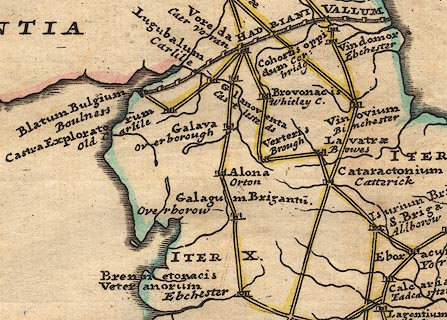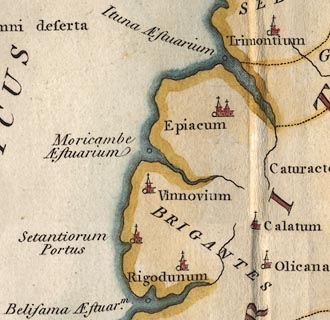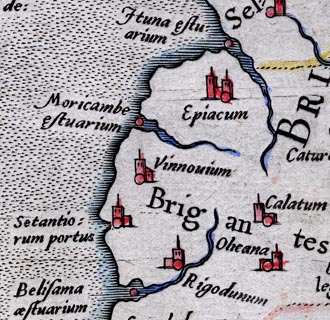




placename:- Overboro
placename:- Galagum
 click to enlarge
click to enlargeStu1Cm.jpg
"Galagum / Overboro"
item:- Hampshire Museums : FA2001.171
Image © see bottom of page
placename:- Bremetonaca
item:- roman altar
 goto source
goto sourceGentleman's Magazine 1759 p.407 "Mr URBAN,"
"MR Rauthmell, in his Antiquitates Bremetonacenses, seems to have sufficiently proved, that Overborough is the Bremetonaca, or Bremetonacae, of Antoninus. Amongst his others proofs, he has produced a Roman altar, found in an old building near Overborough, and given to him by Mr Fenwick, which is exceeding a propos, since Mr Cambden, who first imagined this place might be Bremetonaca, had vouched, in proof of it, certain inscriptions upon stones, and Dr Gale and Mr Horsley, from Cambden, had taken notice of the same. The inscription upon this altar Mr Rauthmell has caused to be engraved, but is, in my opinion, extremely unfortunate in reading and interpreting it; indeed he is but a bad writer, and, I think, no better an antiquarian. The inscription is,"
"DEOSAN / GONTR / EBIVAT / TAPOSV."
"Which he divides, reads, and explains on this manner: (2) DEO SAncto MOGONTI REstituta Bonae jam Valetudini ATTA POSuit Votum. But who can make MOGONTI of NGONT? Nor is there any reason why Atta should be supposed to be a woman, as he conjectures. (3) Poneres votum, I doubt, is not Latin; but what is worst, you may at this rate make any thing of any thing. To interpret rebiv, (letters unpointed, and in the middle of an inscription REstituta Bonae tam Valetudini, is a proceeding so arbitrary, and so little supported by the Roman inscriptions in being, that one may be allowed to say, there is no exampleof the like; and indeed were three or four words together to be expressed by initials on the marbles, the inscription would be so obscure and unintelligible, even in the age it was written, that no reader, at least no vulgar reader, would ever be able to comprehend it. Such inscriptions would rather tend to puzzle than instruct a reader. Setting aside, therefore, all he has amassed together about the god Magon, or Mogon, whom he supposes to be a British deity, answering to the Sun, or Apollo, the god of physic or health, and afterwards to have been adopted and worshipped by the Romans at this station. (4) I am entirely for trying a new method of reading and interpreting this inscription; and if I may but be allowed to suppose that the S at the top of the first V, which, I imagine, was written thus, V
"DEO. SAN / GON. TR / EBIV
"That is, in words at length DEO SANGO Numerius TREBIVS ATTA POSVit."
"Now, in favour of the emendation, I have to observe, that there seems to have been a substantial reason for the alligation of the V and S; for otherwise the name of the votary ATTA could not have been commodiously divided; if the S had been cut at large, there could only have been the A in that line."
"This Sangus, or Sancus, for he is written both ways, was originally a Sabine deity, but afterwards was in great request at Rome. According to Varro, he was the same as Hercules, and consequently was a proper diety for a soldier to honour. He was the principal deity of the Sabines, is mentioned by many authors, but is peculiarly famous on account of the mistake committed by Justin Martyr, (5) Tertullian, (6) and others, in respect of him. The mistake was this: these fathers charged the Romans with dignifying the great impostor Simon Magus with a statue and inscription, which statue, Justin Martyr says, was erected in the Tiber, between two bridges, and bore this Latin inscription, Simoni Deo Sancto. But now,"
"(1) Mr Rauthmell makes a Nominative to be Bremetonacae, but Dr Gale, in his commentary on Antoninus, supposes it to be rather Bremetonaca. The ablative in the author, Bremetonacis, will admit of either. Cambden gives it in the singular, Bremetonacum, not correctly. N.B. It is also written Bremetonaca. Dr Fulk, in the 2d edit. of Burton's comment on Antoninus, places Bremetonaca at Trentham in Staffordshire, very absurdly."
"(2) See p.96."
"(3) See p.67."
"(4) See p.96."
"(5) Justin Mart. Apolog. I."
"(6) Tertullian Apolog. c. xiii."
 goto source
goto sourceGentleman's Magazine 1759 p.408 "in the year 1574 (sic), a stone was dug up in an island of that river, inscribed Semoni Sanco Deo Fideo, &c. from whence it is evident, in the opinion of most, that those fathers misread and misinterpreted this stone, it being the individual stone and inscription which they had beheld. See Hevercamp ad Tertull. Apolog. c. xiii. the annotators on Ovid's Fasti, Lib. vi. 213. seq. in Burman's edition, and Dr Thirlby, in his edition of Justin Martyr. I do not remember, at present, to have found any mention of the Trebian family at Rome, but Atta is a legitimate Roman name, as appears from these lines of Horace."
"Recta nec ne crocum floresque perambulet Attae Fabula, si dubitem, clament periisse pudorem Cuncti pene patres. Hor. 2. Epist i. 79."
"This was Titus Quinctius Atta, a comic poet. The word Atta, which was a cognomen also in the Sempronian family, (7) and, as appears from this inscription, in the Trebian, signifies, according to Pompeius Festus, in voce, a lame person."
"Amongst the authors that mention the god Sangus, are Paulus and Festus, in the word Sanqualis avis, which they interpret Ossifraga, or the osprey, testifying that this bird was under the protection of Sangus. On one side of the altar in question there is the figure of a bird, which doubtless was intended for the Sanqualis Avis. Mr Rauthmell fluctuates stragely about it: first, he does not know what to make of it; then he says, (8) it appears to him to be the portraiture of an owl; and afterwards, that it certainly has, in his opinion, the resemblance of an owl. An owl it is, unquestionably, in his type, and the owl, and not the osprey, was the Sanqualis, or Sanqualiss Avis, in the opinion of the mason that cut this stone; for it must be remembered, that authors are not well agreed as to the Sanqualis Avis. See Pliny, lib. x. c. 7. However, that our mason, who intended to exhibit the Sanqualis Avis, was mistaken in giving us the owl for it, I make no manner of doubt."
"Yours, &c."
"P. GEMSEGE,"
placename:- Bremetonacae
 goto source
goto sourceTour to the Caves in the West Riding of Yorkshire, late 18th century
Page 243:- "..."
"Our ideas of the beauties of art and nature were mellowed and refined by those of venerable antiquity. We were now on classic ground, Overborough being most undoubtedly a Roman station and garrison - the Bremetonacoe (sic) of the emperor Antoninus, as may be collected from Tacitus and other ancient writers. Bremetonacae is placed twenty Roman (or eighteen English) miles north of Coccium, or Ribchester, and twenty-seven Roman (or twenty-four English) miles south of Galacum, which some antiquaries conceive to be Apulby, though others with more probability think it was Brough: the distances correspond, besides the additional argument of their being nearly in the same direction, whether we conceive Galacum to be Apulby or Brough. The Roman road is easily traced from Ribchester into Yorkshire, running on the north side of Slaidburn, through Crossa-Greta, then on the north side of Tatham Chapel, through Bentham, to Overborough; [1] afterwards the Roman road goes through Casterton and Middleton, and, as some think, by Borrow-bridge and Orton, to Apulby. Others, and perhaps from better reasons, are of opinion, the road went by Sedbergh, or Sedburgh, [2] over Blewcaster, along Ravenstonedale-street, and through Kirkby-Stephen, to Brough or Burgh. For Antoninus's tenth Itinerary runs from Glanoventa or Lanchester, in the county of Durham, by Galacum, Bremetonacae, Coccium, Mancunium or Manchester, to Glenovento or Draton, in the county of Salop. In various places by the side of this road are high artificial mounts of earth, which were without doubt the stations of centinels, to prevent any insurrections, or being surprised by an enemy: they may be now seen entire at Burton-in-Lons-"
"[1] A full account of the antiquities of Bremetonacae, or Overborough, may be seen in a quarto volume, published by Richard Rauthmell."
"[2] Chester, or caster, is derived from the Latin word castrum, or camp. Street is derived from the Latin word stratum, or military road, or causeway. Borough, or Burgh, from the Greek word burgos, or watch tower."
 goto source
goto sourcePage 244:- "[Burton-in-Lons]dale, Overborough, Kirkby-Lonsdale, and Sedbergh. There are several lateral ones, as at Lune-bridge near Hornby, at Melling, and Wennington. On our return we had the bridge full in view most of the way: its antiquity and greatness made its presence venerable and respected. ..."
placename:- Calatum
 click to enlarge
click to enlargePTY3Cm.jpg
"Calatum"
item:- Hampshire Museums : FA2002.651
Image © see bottom of page
 click to enlarge
click to enlargePty1Cm.jpg
item:- private collection : 13
Image © see bottom of page
placename:- Bremetonacae
 goto source
goto sourcePage 177:- "..."
"A mile onward [from Tunstall church] is OVERBOROUGH, or Burrow: ..."
"ROMAN STATION.- Immediately on passing Leck Beck, we arrive on 'classic ground,' - the site of the Bremetonacae of Antonine. Burrow Hall, a respectable mansion of the last century, is erected upon the Praetorium, but at this day no remains exist to tell 'where once the City stood.'"
placename:- Calacum
placename:- Galacum
placename:- Calatum
